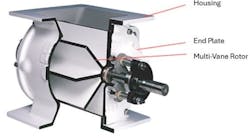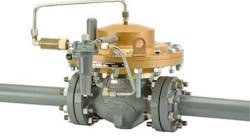Each piece of equipment and machinery used in the food and beverage processing industry is different and has a unique set of sealing requirements. Caio Beraldo, technical manager for food, beverage and water at Trelleborg, discusses the uses and sealing needs for rotary fillers.
Q: What is a rotary filler?
A: A rotary filler is a machine that moves containers down the production line through different circular stations via a turret, or rotating holder. It loads product vertically via a conveyor belt that passes bottles under the filling head. Rotary fillers operate continuously and do not need to stop when bottles are filled. They also include additional circular stations for sealing, capping and labeling.
Q: More specifically, what are they used for?
A: Rotary fillers are best suited for any kind of mass-produced beverage such as beer or bottled water, along with some solids including infant formula, non-dairy creamers, spices and baking soda. They have a high capacity of 20 to 50 heads and are great for high-production volumes and constant output.
Q: What are some key considerations for rotary filler original equipment manufacturers (OEMs)?
A: Rotary fillers need to operate with speed and precision. Depending on the type of product interacting with the rotary fillers, different fluid viscosity variations are important. Additionally, as they are the preferred choice over linear fillers for high-volume production, rotary filler OEMs look to increase service life and cleanability and reduce maintenance and downtime of the filler.
Q: What types of seals help protect these components in rotary fillers?
A: Rotary fillers need several seals including linear seals for the piston fillers, Hi-Clean and Ultra-Clean rotary seals for circular stations, and static seals such as O-Rings, gaskets, bonded seals and molded parts for the filling heads, flange joints, threads and covers.
Q: And what do you mean by Hi-Clean and Ultra-Clean?
A: Hi-Clean seals are hygienically designed variations of spring-energized seals, made from food-grade polymers, and have spring cavities filled with food-grade silicone, meaning no food contact with the spring. Ultra-Clean seals have a polytetrafluoroethylene (PTFE)-based jacket that fully encapsulates the spring so the only thing touching food products is the PTFE-based material. Both eliminate dead space where bacteria could potentially build up.
Q: Do you have any real-life examples to illustrate these sealing applications?
A: A customer was having issues with the seals used in their rotary filler distributors. The operating parameters were standard, but the seals could not stand up to the cleaning media (acids, alkaline solutions, water steam, hydrogen peroxide and ozonized water). The seals showed high wear after a few hours of operation and immediate leakage when in contact with specific drinking liquids (sparkling wine, beer, soft drinks, etc.). The customer needed to replace its existing PTFE lip seal and static O-Ring combination with a solution that had a longer lifetime of about 3,000 operating hours and was interchangeable for easy maintenance.
We designed a double acting, single-component solution that replaced the dynamic seals and static O-Ring without any changes to the customer’s hardware. The sealing material, part of Trelleborg’s FoodPro range, had low friction, chemical compatibility with the cleaning agents used in clean-in-place (CIP) processes and was FDA-approved with heavy load V-springs for optimum sealing under low pressures. It was also compliant with all globally relevant food contact regulations making it easier for the customer to export the equipment anywhere in the world.


